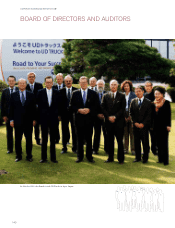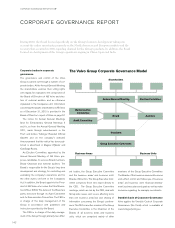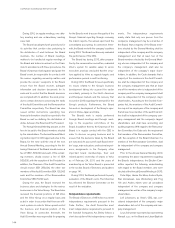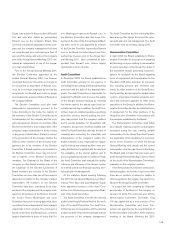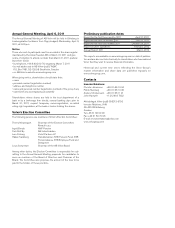Volvo 2010 Annual Report Download - page 151
Download and view the complete annual report
Please find page 151 of the 2010 Volvo annual report below. You can navigate through the pages in the report by either clicking on the pages listed below, or by using the keyword search tool below to find specific information within the annual report.Risk assessment
Risks relating to the financial reporting are
evaluated and monitored by the Board through
the Audit Committee inter alia through identi-
fying what types of risks that typically could be
considered as material and where they would
typically occur. The annual evaluation of internal
control activities conducted by the Internal
Control and Internal Audit functions, are based
on a risk-based model. The evaluation of the
risk that errors will appear in the financial
reporting is based on a number of criteria.
Complex accounting principles can, for example,
mean that the financial reporting risks being
inaccurate for those posts that are covered by
such principles. Valuation of a particular asset
or liability according to various evaluation cri-
teria can also constitute a risk. The same is
true for complex and/or changing business
circumstances.
Control activities
In addition to the Board of AB Volvo and its
Audit Committee, the Boards and manage-
ment groups of Group companies constitute
the overall supervisory body.
Several control activities are applied in the
ongoing business processes to ensure that
potential errors or deviations in the financial
reporting are prevented, discovered and correc-
ted. Control activities range from review of out-
come results in management group meetings to
specific reconciliation of accounts and analyses
of the ongoing processes for financial reporting.
CFOs in Group companies are ultimately respon-
sible for ensuring that control activities in the
financial processes are appropriate and in accor-
dance with the Group’s policies and instructions.
They are also responsible for ensuring that autho-
rity structures are designed so that one person
can’t perform an activity and then perform the
control of the same activity. Control activities
within IT security and maintenance are a key part
of Volvo’s internal control over financial reporting.
Information and communication
Policies and instructions relating to the financial
reporting are updated and communicated on a
regular basis from management to all affected
employees. In addition, there are a number of
committees and networks within Volvo that serve
as forums for information and discussions regar-
ding issues relating to the financial reporting and
application of internal rules. Included in these
committees and networks are representatives
from the business areas and the Group’s staff
units who are responsible for financial reporting.
Work in these committees and networks is
aimed, among other things, at ensuring a uniform
application of the Group’s policies, principles and
instructions for the financial reporting and at
identifying and communicating shortcomings
and areas of improvement in the processes for
financial reporting.
Follow-up
Ongoing responsibility for follow-up rests with
the business areas’ management groups and
accounting and controller functions. In add-
ition, the Internal Audit and the Internal Con-
trol functions conduct follow-up and supervi-
sion in accordance with what is described in
the introduction of this report. More specifi-
cally, the Internal Control function runs and
coordinates evaluation activities through the
“Volvo Group Internal Control programme”,
which gives a systematic way of evaluating the
quality and effectiveness of the internal con-
trol over financial reporting on a yearly basis. A
yearly evaluation plan is settled and presented
to the Audit Committee. This evaluation pro-
gramme comprises three main areas:
1. Group-wide controls: Self assessment pro-
cedure carried out by management teams at
business area and business unit level as well
as local company level. Main areas evalu ated
are the adherence to the Group’s financial
directives and policies found in FPP along
with The Volvo Way and the Group’s Code of
Conduct.
2. Process controls at transaction levels: Pro-
cesses related to the financial reporting are
evaluated by testing of specific routines and
controls based upon the Group’s framework
for internal control over financial reporting,
VICS – “Volvo Internal Control Standards”.
The framework focus on the financial reporting
areas deemed to have a relatively higher risk
for potential errors because e.g. complex
accounting principles, complex or changed
business operations etc.
3. General IT controls: Processes for mainten-
ance, development and access management
of financial applications are evaluated by tes-
ting of routines and controls.
The results of the evaluation activities are
reported to the Group management and the
Audit Committee.
Göteborg, February 24, 2011
AB Volvo (publ)
Board of Directors
Auditor’s report on the Corporate
Governance Report
It is the Board of Directors who is responsible
for the Corporate Governance Report on pages
142–147 and that it has been prepared in
accordance with the Annual Accounts Act.
As a basis for our opinion that the Corporate
Governance Report has been prepared and is
consistent with the annual accounts and the
consolidated accounts, we have read the Cor-
porate Governance Report and assessed its
statutory content based on our knowledge of
the company.
In our opinion, the Corporate Governance
Report has been prepared and its statutory
content is consistent with the annual accounts
and the consolidated accounts.
Göteborg, February 24, 2011
PricewaterhouseCoopers AB
Göran Tidström
Authorized Public
Accountant
Lead Partner
Johan Rippe
Authorized Public
Accountant





